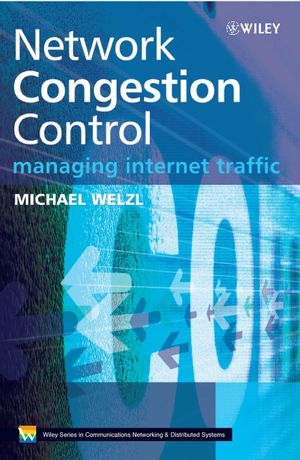Network Congestion Control: Managing Internet TrafficISBN: 978-0-470-02528-4
Hardcover
288 pages
September 2005
 This is a Print-on-Demand title. It will be printed specifically to fill your order. Please allow an additional 10-15 days delivery time. The book is not returnable.
|
||||||
Preface.
List of Tables.
List of Figures.
1. Introduction .
1.1 Who should read this book?
1.2 Contents.
1.3 Structure.
2. Congestion control principles.
2.1 What is congestion?
2.2 Congestion collapse.
2.3 Controlling congestion: design considerations.
2.4 Implicit feedback.
2.5 Source behaviour with binary feedback.
2.6 Stability.
2.7 Rate-based versus window-based control.
2.8 RTT estimation.
2.9 Traffic phase effects.
2.10 Queue management.
2.11 Scalability.
2.12 Explicit feedback.
2.13 Special environments.
2.14 Congestion control and OSI layers.
2.15 Multicast congestion control.
2.16 Incentive issues.
2.17 Fairness.
2.18 Conclusion.
3. Present technology.
3.1 Introducing TCP.
3.2 TCP window management.
3.3 TCP RTO calculation.
3.4 TCP congestion control and reliability.
3.5 Concluding remarks about TCP.
3.6 The Stream Control Transmission Protocol (SCTP).
3.7 Random Early Detection (RED).
3.8 The ATM‘Available Bit Rate’ service.
4. Experimental enhancements.
4.1 Ensuring appropriate TCP behaviour.
4.2 Maintaining congestion state.
4.3 Transparent TCP improvements.
4.4 Enhancing active queue management.
4.5 Congestion control for multimedia applications.
4.6 Better-than-TCP congestion control.
4.7 Congestion control in special environments.
5. Internet traffic management – the ISP perspective.
5.1 The nature of Internet traffic.
5.2 Traffic engineering.
5.3 Quality of Service (QoS).
5.4 Putting it all together.
6. The future of Internet congestion control.
6.1 Small deltas or big ideas?
6.2 Incentive issues.
6.3 Tailor-made congestion control.
Appendix A: Teaching congestion control with tools.
A.1 CAVT.
A.1.1 Writing script.
A.1.2 Teaching with CAVT.
A.1.3 Internals.
A.2 ns.
A.2.1 Using ns for teaching: the problem.
A.2.2 Using ns for teaching: the solution.
A.2.3 NSBM.
A.2.4 Example exercises.
Appendix B: Related IETF work.
B.1 Overview.
B.2 Working groups.
B.3 Finding relevant documents.
Appendix C: List of abbreviations.
Bibliography.
Index.



